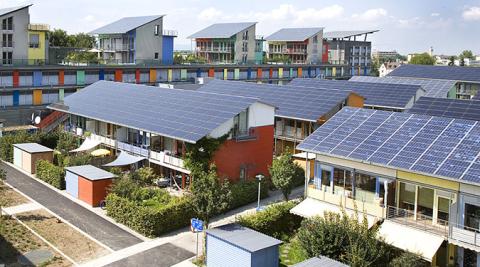Just Say No
Despite its bad rap, NIMBY can be good for everyone, Professor Carol Hager writes.
Not In My Backyard (NIMBY) protests against large development projects are commonly dismissed as backward-looking, uninformed, and selfish.
Contrary to its negative stereotype, NIMBY can be beneficial to participatory politics. NIMBY protests can initiate a process of community learning that enhances citizen self-understanding, fosters democratic politics, advances technical expertise, and helps frame larger issues. And, at its best, that process can yield innovative solutions that might serve as models for others.
Consider the evolution of the Black Forest region from rural idyll to Germany’s solar region, a center of innovation in renewable-energy technology and in local-level environmental activism. This story is tied inextricably to a NIMBY protest.
In the early 1970s, the German, French, and Swiss governments announced plans to transform the region into a massive industrial zone, with no fewer than 14 nuclear power plants, plus chemical, metal, and petroleum processing facilities. In this deeply conservative, largely rural region, small farmers, vintners, clerics, and university students from nearby Freiburg overcame barriers of class, occupation, and tradition to mobilize against the industrial build-out.
They organized petition campaigns, filed legal actions, mobilized mass demonstrations, and occupied the disputed sites in order to stop construction. Dismissed by the state and national governments as backward-looking NIMBY protesters, activists pushed back, characterizing the development plans as unnecessary, technologically unsound, and environmentally and socially destructive.
Mass mobilization against a nuclear plant near the West German village of Wyhl started a national conversation about economic growth and energy policy. Residents raised concerns about the risks that a nuclear power facility posed for neighboring communities, they objected to a planning process that had excluded local voices, and they questioned the assertion that perpetually expanding energy use was vital to economic growth.
Protesters staged an eight-month-long site occupation that drew participants from West Germany, France, and Switzerland. They hosted discussions about the pros and cons of various energy sources. The protesters, including university students, scientists, and local tradesmen, began experimenting with solar collectors at the site.
Scientifically and technologically forward-looking, the Wyhl protest defied the NIMBY stereotype. Moreover, it worked. The state government withdrew the proposal, and Wyhl became the touchstone for ongoing nuclear protest nationwide and arguably the site at which Germany’s famed Energiewende (transition to renewable energy) was born. Support for renewable energy has become a hallmark of German politics; in 2011, the German federal government announced the phase-out of both nuclear and coal-fired power plants.
Wyhl gave rise to a self-reinforcing network of innovation. Locals opened hundreds of renewable-energy businesses. Veterans of the occupation founded a scientific research institution, the Eco-Institute in Freiburg, and brought renewable-energy education to the local trade school and university. Freiburg became the home of the largest solar R&D institution in Europe.
Now known as Germany’s solar region, the area draws visitors from all over the world to learn about locally generated, environmentally sustainable energy solutions. As one long-term activist puts it, “Every pioneering activity here leads back to Wyhl.”
Carol Hager is Professor of Political Science on the Clowes Professorship in Science and Public Policy at Bryn Mawr.
A NEW LOOK
Read Carol Hager's article from October 2017 in Items, The Social Science Research Council's digital forum:
Published on: 04/03/2018
